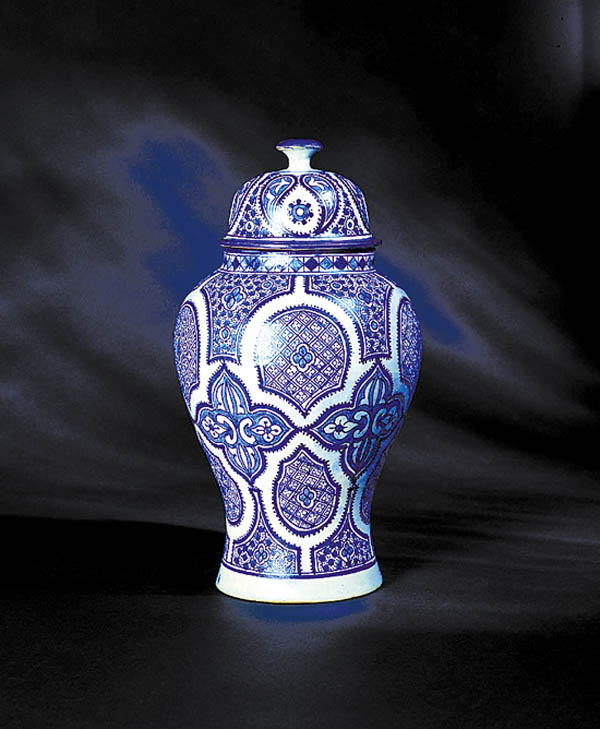Moroccan Ceramics Are Rich In History
As early as Neolithic times, Berbers employed the coiling technique to make functional pottery. By the fifth century B.C., however, during the period of Carthaginian domination, the wheel was introduced into Moroccan coastal towns and was used in pottery making. By the Roman period, from the second century B.C. to the seventh century A.D., methods for producing pottery became more refined. "Terra Sigillata" was widely made with impressed motifs and light glazing. Urban Moroccan pottery appears to have been produced from as early as 814 A.D. (under the rule of Idriss II) when thousands of potters skilled in glazing methods came to Fez in Morocco from Cordoba in Spain. The Almoravid Dynasty in the eleventh and twelfth centuries saw an increase in pottery manufacture and the advent of a thriving ceramics industry. At the beginning of the thirteenth century, a survey of the city ordered by the Almohad ruler al-Nasir Muhammad (1199-1213) listed 188 ceramic workshops and, by the fourteenth century glazed, polychromed earthenwares were introduced, utilizing a double firing technique that successfully fixed enamel colors.
Zillij, an ancient Moroccan pottery tradition, dates back hundreds of years and is used to make hand-cut ceramic tiles. Drawing inspiration from Persian ornamentation and Roman mosaics, zillij is the Moroccan mosaic art of decorating architecture, floors, and walls with multi-colored hand cut tiles that are decorated with intricate geometrical patterns. Moroccan mosaic work is not limited to the Islamic period, nor is it unique to Morocco. Not far from the city of Fez are the remains Volubilis, a Roman city containing intricate marble floor mosaics. In Muslim Spain (al-Andalus) zillij reached an apex that remains evident in the Alhambra and Alcazar palaces.
Beginning in the middle of the eleventh century, the Almoravid rulers, and later the Almohads, introduced zillij to buildings in their imperial cities in Morocco and Spain. Examples may still be seen in dynastic landmarks like the minaret of the Kutubiyya Mosque in Marrakech, the Hassan Tower in Rabat, and the Giralda in Seville. Today, zillij is also applied to tabletops that are often set on wrought iron bases. Zillij production is extremely time consuming and labor intensive and requires the skills of highly trained artisans. Costly to install, private patronage remains a factor in perpetuating the art. In zillij creation, individual ceramic pieces, called furmah, are painstakingly cut from glazed tiles. Then thousands of furmah are placed face down on the floor to create patterns. Precision is prerequisite in order for edges to join flawlessly. After the pieces are set in place, a concrete mixture is poured over the back to create a slab which, when set, can be fixed to a wall, floor, or other surface. A zillij artist is called a zlayji in Moroccan Arabic. Many scholars and art historians feel that the art of zillij reached its apex in the sixteenth century in Marrakechs Saadian Tombs; however, royal palaces and public buildings built between 1961 and 1999 by King Hassan II exhibit exemplary contemporary mosaic work. Mosaics are also found outside the madinah, in modern Fez, and may also be seen in building façades and lobbies, café counters, and even sidewalk flower planters. In the madinah, zillij adorns the fourteenth-century Attarine and Bou Inaniyya madrasas or Islamic schools, the Qarawiyyin mosque, and the tomb of Moulay Idriss II, who founded Fez. The book Zillij: The Art of Moroccan Ceramics by John Hedgcoe and Salma S. Damluji is an excellent reference for further study.
Today, there are four major centers of pottery production in Morocco: Wadi Lan, Rabat, Safi, and Fez. Wadi Lans rich red soil is ideal for making unglazed terracotta wares - oil lamps, charcoal burners, cooking utensils, and simple ovenproof wares that are popular with tourists. On the banks of the river Abu Reg Reg, located in the Rabat region, a substantial colony of potters creates various glazed and unglazed wares; the style of Rabat pottery has been greatly influenced by French colonists, and traditional Islamic designs are produced in conjunction with more contemporary styles. On the Atlantic coast of Al Jorfal Asfar (the "Yellow Coast"), yellow clays are used to make pottery at Safi, in particular, large dishes and bowls decorated with curving black lines and overglazed with a greenish-blue color called turquoise by the French. Safi ceramics are among the most popular in Morocco and are known for their colorful representations of both traditional and contemporary motifs. Today, Safi is internationally acclaimed as one of Moroccos most important pottery-making centers.
Fez, the oldest city in Morocco, is world-known for its blue pottery, called Bleu de Fez by the French and Fakhari by local residents. During the thirteenth century a census showed 124 potters workshops in Fez, and, by the sixteenth century, a section of Fez called Fakhkharin was devoted to pottery production. Two clay types from Bin Jelleih are widely used by Fez potters: a creamy yellow clay (from the upper strata) that is used in the production of storage jars and water cups, and a clay from the lower strata that is dried in the sun before biscuit firing in kilns to achieve a white body that is ready for decoration.
Items made from lower strata clay include a range of pots, bowls, and dishes with blue-on-white decoration applied by accomplished artisans, many of whom were apprenticed to the trade as children. One of the most popular items is the jebana, a dome-lidded container that was traditionally used to store the local cheese called jbna. When modern refrigeration rendered the jebana obsolete in its cheese-storing capacity, its function was translated to soup tureens, often sold today with bowls called zalafa and used during Ramadan to serve the hot soup known as haria. Also popular are tangines, glazed and unglazed earthenwares, which consist of shallow round dishes with conical lids that capture both steam and flavor while foods simmer during slow cooking.
Blue pottery from Fez originated as a result of cobalt derived from the rocks and stones that are river-swept into the Wadi Mellih gorge. When ground to a fine powder, these stones produced the materials needed to create blue glazes. Today, however, the cobalt is no longer plentiful and glazes are imported. Bleu de Fez designs are characterized by intricate geometric patterns that adhere to Islamic dictates. Potters mix the finely ground powders obtained from mineral sources with varying amount of water to realize different colors and tones. Decoration is applied by master craftsmen, often with handmade horsehair and bamboo brushes.
Moroccan pottery is noted for its vibrant colors and for its floral decoration, palm tree motifs, and arabesques. Most specifically it is defined by complex geometric designs that emanate from circular patterns with extensive repetition, symmetry, and changes in scale that often create complex effects. Deep dishes, vases, tea sets, and cooking wares are specialties of regional ceramicists. Together they suggest the rich heritage of Islamic art, Moorish-Spanish influences, and Berber utilitarian simplicity.
Note: Acknowledgment is made to Talisman Trading (www.talisman-trading.co.uk/, +44(0)20 8963 9988, Unit 117 Park Royal Business Centre, 19-23 Park Royal Road, London NW10 7JH, England) and Maroque (www.maroque.co.uk/, (01449)723133, Maroque, Burnley House, 37 High Street, Needham Market, Ispwich, England) for kindly sending us images to illustrate this article.









